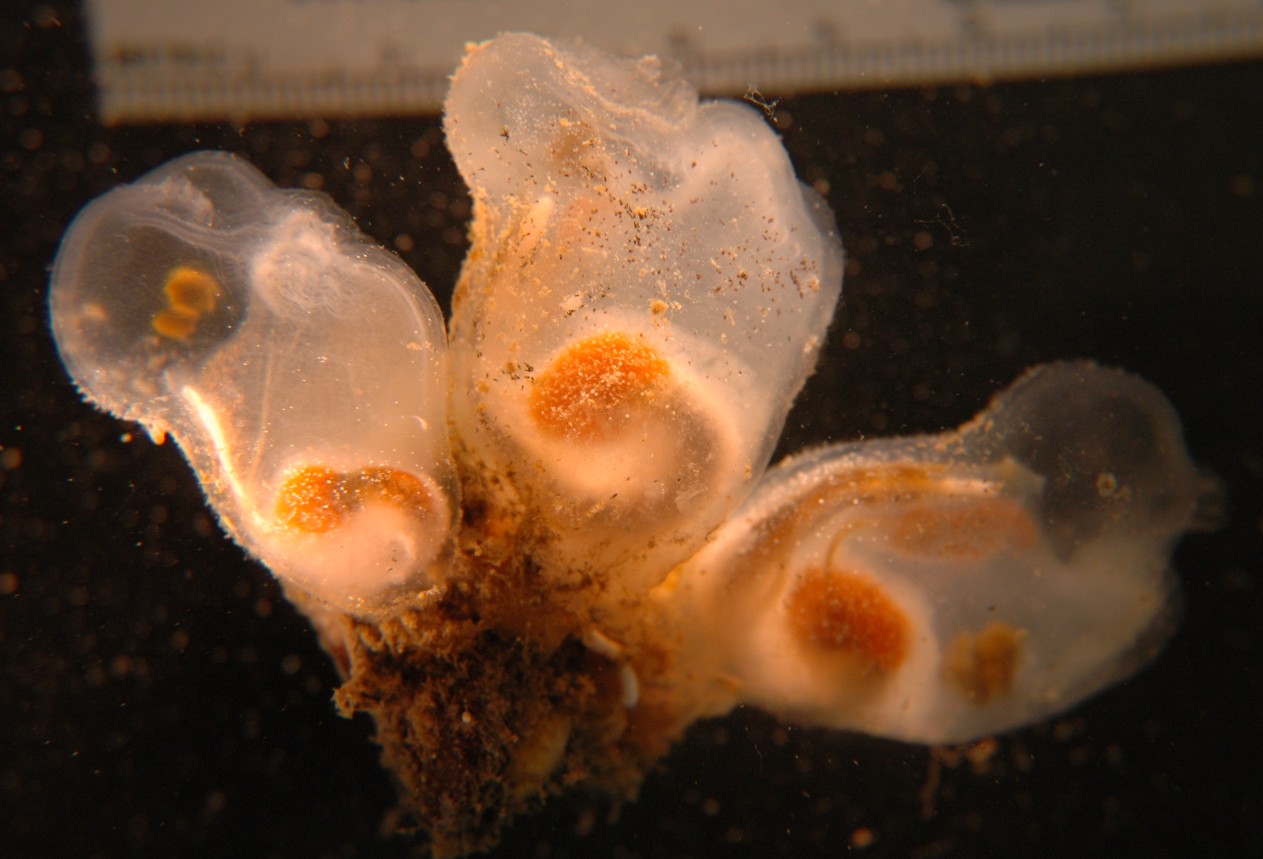Corella inflata Huntsman, 1912Common name(s): Brooding transparent tunicate, Transparent tunicate, Transparent sea squirt |
|
| Synonyms: See also Corella willmeriana |  |
| Phylum Chordata
Subphylum Urochordata Class Ascidiacea Order Phleobranchia Family Corellidae |
|
| Corella inflata from docks, Anacortes, WA. Scale in background is mm. | |
| (Photo by: Dave Cowles, July 2006) | |
How to Distinguish from Similar Species:Molgula pacifica has much foreign material incorporated into the tunic and the atrial siphon is about twice as long as the oral. The tunic of Ascidia paratropa is covered with many large papillae. Ciona intestinalis is several times taller than wide and has visible longitudinal muscle bands. Corella willmeriana is very similar to this species but has a rectum more than 3/4 the length of the body and its atrial siphon is not expanded into a brood chamber.
Geographical Range: British Columbia and the San Juan Islands
Depth Range: 0 to 20 m
Habitat: Common on floats, plus can be found intertidally and subtidally
Biology/Natural History: This species has sometimes been mistaken for Corella willmeriana, which has a larger geographic range and lives deeper. The eggs of this species float (due to replacement of sodium by ammonium in follicle cells) and are thus trapped in the atrial pocket, which extends upwards. After hatching as tadpole larvae, they swim for a short time (minutes to hours) then settle and metamorphose. Many larvae often settle in the same place (on clean surfaces), leading to aggregated adults. At Friday Harbor, the species becomes mature at 3-4 months and lives for 5-8 months. Breeding is year-round. They have 12 chromosomes. Predators include the flatworm Eurylepta leoparda and the seastars Mediaster aequalis, Solaster dawsoni, and Pteraster tesselatus. The colonial tunicate Diplosoma macdonaldi may overgrow it in the winter months. White flecks seen in the mantle are uric acid crystals. The species concentrates iron but not vanadium. One can observe the periodic reversal of blood flow in this species.
| Return to: | |||
| Main Page | Alphabetic Index | Systematic Index | Glossary |
References:
Dichotomous Keys:Flora and Fairbanks, 1966
Kozloff 1987, 1996
General References:
Morris
et al., 1980
Sept,
1999
Scientific
Articles:
[Many articles about C. willmeriana may actually be
about this
species]
Lambert, G., C.C. Lambert, and D.P. Abbott, 1981. Corella species in the American Pacific Northwest: Distinction of C. inflata Huntsman, 1912 from C. willmeriana Herdman, 1898 (Ascidiacea, Phlebobranchia). Canadian Journal of Zoology 59: 1493-1504
Zeng, Liyun, Molly W. Jacobs, and Bill J. Swalla, 2006. Coloniality has evolved once on Stolidobranch ascidians. Integrative and Comparative Biology 46:3 pp 255-268
Web sites:
General Notes and Observations: Locations, abundances, unusual behaviors:
Authors and Editors of Page:
Dave Cowles (2006): Created original page